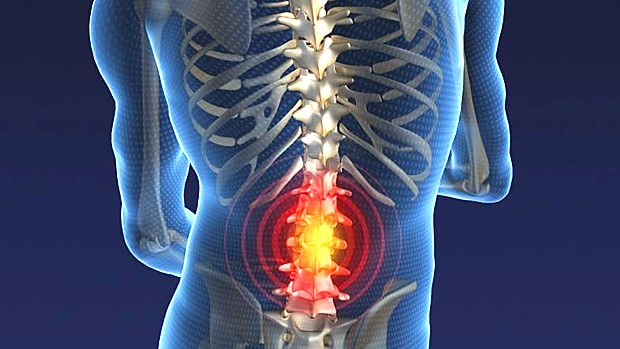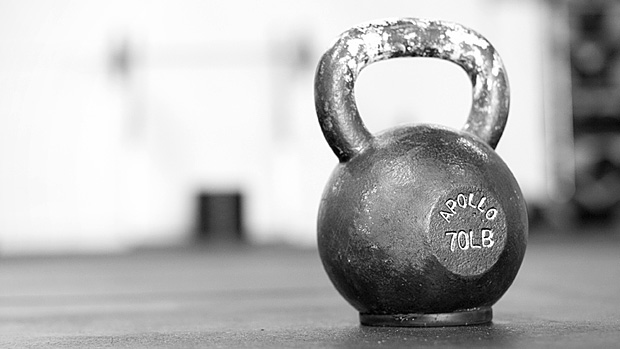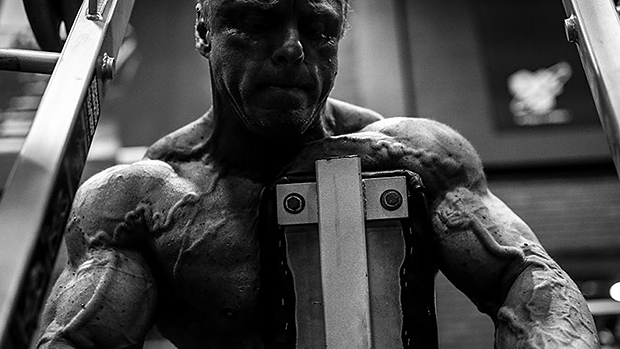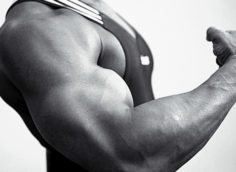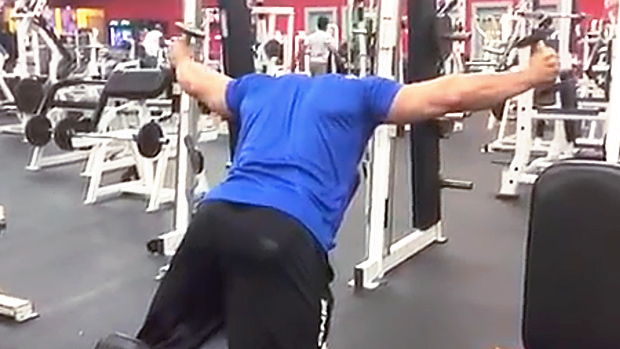I like to think of myself as the thinking man's coach. I'm always evaluating my own programs and what's currently being taught by other professionals in the hopes of finding better, more efficient ways of doing things.
When it comes to my evaluation process, I use a very simple philosophy: "If it doesn't make scientific sense, and it defies common sense, then it must be nonsense."
As I've evaluated some of the exercises commonly used as dynamic warm ups, I've concluded that many of them don't jibe with either common or scientific sense. By deductive reasoning, I've concluded that these movements are based on nothing but nonsense, and should be eliminated from our program. I call these movements the Warmup Don'ts, and I hope that by the end of this article you too will avoid them like you would avoid a warm decaf soy latte.
Because of the vast popularity of these exercises, it's very likely that you're practicing some of them in your program. In addition, many of these movements are currently being taught by several well-respected coaches.
Well, in this article I'm going to provide you with a whole bunch of science and a solid rationale for why these movements both fail to promote proper movement patterns, and, based on recent research, may actually lead to dysfunction. Rather than telling you what to do and why, I'm going to try to teach you what not to do, and why not to do it. As the great Bruce Lee once said, "It's not the daily increase, but the daily decrease. Hack away the unessential."
1 – The Scorpion Twist

Truth be told, I have always thought that the scorpion was popular only because it looked cool. I have never used it because in my opinion it felt very unnatural and had no real functional carryover.
My personal opinion aside, the fundamental flaw with the scorpion twist is that it requires the athlete to simultaneously extend and rotate the spine. This type of motion can cause stress to the spinal facet joints. According to Dr. Wolf Schamberger in The Malalignment Syndrome: Implications for Medicine and Sport (2002):
"The facet joints are stressed non-specifically on side bending, back extension alone and back extension combined with rotation to the right or left." (p. 244)

Facets are small joints that overlap like shingles on a roof, forming the back surface of the spine.
Similar writings can be found later in the article:
"Loads on the facet joints of the lumbar spine may play a major role in low-back pain. Shear forces resulting from axial rotation and flexion-extension motions (compressive shear loads) are mainly transmitted through the facet joints. Although traumatic or transient shear forces will be resisted by both the disc and the facets, the disc's viscoelasticity causes slowly applied or constant shear loads to pass through the facet joints." (Hassan A. Serhan, Ph.D.; Gus Varnavas, M.D.; Andrew P. Dooris, Ph.D.; Avinash Patwardhan, Ph.D.; Michael Tzermiadianos, M.D.; Biomechanics of the Posterior Lumbar Articulating Elements, 2007)
This article than goes further into the types of pain caused by facet stress and compression:
"Facet joint compression leads to at least three causes of back pain: spinal osteoarthritis; bulging and herniated discs; and nerve root impingement... Because the nervous system is responsible for many other activities, the effects of facet joint compression are very wide ranging."
Recent research also suggests that you're ten times more likely to suffer sciatica pain from facet compression injuries than from herniated discs.
With this type of evidence, it's easy to see why the scorpion twist is a Warmup Don't.
2 – The Prone Alternating Superman

The prone alternating superman exercise is probably the most widely used exercise in my Warmup Don'ts list. I've seen this exercise used by just about everyone in the health and fitness industry from sport coaches to Pilates instructors, and even physical therapists.
In the book Fact and Fallacies of Fitness (2003), Mel Siff thoroughly explains why the prone alternating superman is a Warmup Don't:
"Since the lower extremities are heavier than the upper extremities, this can impose a torque or twisting action around the lumbar spine if the action of the extremities isn't well synchronized and instead of reducing any potential risk of hyperextension, it can add an element of rotation to the extension, thereby making this exercise less safe than controlled gradual simultaneous raising of the legs and arms. In fact, it's not uncommon for this exercise to cause acute back pain and spasm." (Siff, p.36)
Siff then goes on to say that "Current research has shown that the superman exercise and several of its variations have little or no benefit on back strength and posture." (Siff, p.36)
Although Siff advises that it's safer to perform the superman exercise lifting the arms and legs simultaneously, he does mention that the superman is virtually a useless exercise. Therefore, we have eliminated the superman and all its variations entirely from our program.
Additionally, in the past we have had many healthy, pain free athletes complain about discomfort during prone extension type movements like the superman. We feel this is due to the fact that many explosive type athletes tend to have a slightly increased lumbar curve (lordosis) even while practicing a well-balanced program.

With this in mind, having an athlete who is already in lumbar extension perform movements like the scorpion or superman isn't only counterproductive, but extremely risky.
3 – The Windshield Wiper (or Hip Crossover)

This is another one of these exercise that I've seen show up in just about every system of training as either flexibility or as "core strength" exercise. I have even seen coaches overload this movement using a medicine ball between the legs.
I myself was using both the loaded and unloaded version of the windshield wiper until I read an article by Mike Boyle called, Is Rotation Even a Good Idea? In that article, Boyle referenced physical therapist Shirley Sarhmann, who in the book Diagnosis and Treatment of movement Impairment Syndromes Movement explained why movements like the windshield wiper contradict the biomechanics of the lumbar spine.
"Rotation of the lumbar spine is more dangerous than beneficial and rotation of the pelvis and lower extremities to one side while the trunk remain stable or is rotated to the other side is particularly dangerous." (Sahrmann, pg. 72)
"During most activities, the primary role of the abdominal muscles is to provide isometric support and limit the degree of rotation of the trunk which, as discussed, is limited in the lumbar spine." (Sahrmann, p. 70)
Sarhmann then goes on to explain in more detail the rotational range of motion capabilities at the lumbar spine:
"The overall range of lumbar rotation is ... approximately 13 degrees. The rotation between each segment from T10 – L5 is 2 degrees. The greatest rotational range is between L5 – S1... The thoracic spine, not the lumbar spine, should be the site of greatest amount of rotation of the trunk... when an individual practices rotational exercises, they should be instructed to "think about the motion occurring in the area of the chest." (Sahramnn pg. 61-62)
Taking Sarhmann's advice, we've chosen to eliminate exercises that drive spinal rotation from the bottom up in favor of an alternative variation that's driven from the top down, shown below. This version is much easier on the lumbar spine and emphasizes rotation at the thoracic spine, which is better designed for mobility.

Driving spinal rotation from the top down puts less stress on the lumbar vertebrae.
4 – The Iron Cross

The Iron Cross is basically a more dynamic version of the hip cross over. Therefore, based on what I just told you, it should be obvious why it's a Warmup Don't.
The Iron Cross is actually the most poorly designed and dysfunctional movement on my hit list. This movement not only requires excessive lumbar rotation, but also adds a small element of lateral flexion to the mix, as a byproduct of lifting the leg toward the opposite hand. Any qualified physical therapist will tell you that combining spinal lateral flexion with rotation, especially under load, will put you on the fast track to disc injury.
This is mentioned by Gregory S. Kolt and Lynn Snyder-Mackler in their book Physical Therapies in Sport and Exercise (2003):
"The mechanism of back injury in athletes is normally the same as in the general population (i.e. prolonged and or repeated spinal flexion, flexion and rotation under load)." (p. 250)
In the book Fact and Fallacies of Fitness (2003), Mel Siff also makes this point very clear:
"The combination of lateral bending and rotation constitutes one of the most dangerous maneuvers for the lumbar spine." (p. 89)
Siff than continues to make a very important point and explain why rotary training exercises are much safer and more functional when performed in an upright position.
"A certain degree of compressive preloading locks the facet assembly of the spine and makes it more resistant to torsion. This is the reason why trunk rotation without vertical compression may cause disc injury, whereas the same movement performed with compression is significantly safer." (p. 89)
My spider-sense tells me that someone out there are saying, "Oh, come on now, Nick. Surely the exercises you've described in Warm Up Don'ts 1 to 4 can't possibly create enough force to cause any significant pain or dysfunction." Well, bubba, just feast your eyes on the study below, and you'll see why this line of thinking is about as wrong as Gwyneth Paltrow in a fat suit.
A research study took thirty-eight normal healthy young subjects (14 males, 24 females) with mean ages of 23 years (males) and 21 years (females), performed 36 functional rotational tasks of the trunk. The subject's lower extremities were stabilized in a stabilizing platform, allowing the entire motion of flexion-rotation and extension-rotation to take place in the trunk. Of these tasks, 18 were isometric and the other 18 were isokinetic.
The isometric tasks consisted of flexion-rotation and extension rotation from a 20, 40 and 60 flexed trunk in 20, 40 and 60 of axial rotation. The isokinetic activity consisted of flexion-rotation and extension-rotation from upright and flexed postures respectively in 20, 40 and 60 rotation planes at 15, 30 and 60 /s angular velocities.
The results revealed that the males were significantly stronger than females and isometric activities produced significantly greater torque compared to isokinetic efforts. The degree of trunk flexion was not significant; the angle of rotation, although significant, had only a small effect. The 60 trunk rotation was significantly different from 20 and 40 of trunk rotation.
(Kumar S.; Narayan Y.; Zedka M., Strength in combined motions of rotation and flexion/ extension in normal young adults, Ergonomics Volume 41, Number 6, 1 June 1998, pp. 835-852, Taylor & Frances Ltd.)
Pay particular attention to the concluding statement:
"Based on the results and analysis, it is suggested that the motion involved rather than the torque may have a consequential effect in the precipitation of back injuries."
This statement clearly explains that dysfunction can be created just by moving the spine in a non-functional manner regardless of load. So, as in the theme of this article, it's imperative that we do our research and choose our exercises wisely.
5 – The Leg Cradle

The leg cradle is used by many sports coaches to develop mobility in the hip rotators by mainly stretching the piriformis. It's basically a standing variation of the traditional supine piriformis stretch.

This is another one of those movements that I haven't used much because I've never really liked it. I feel that it's a hard movement to coach and thought that it created unnecessary torque on the knee joint. Regardless, I kept giving the leg cradle a chance and used it on occasion. Finally, however, I decided to eliminate it entirely from our program while attending a physical therapy workshop. It was called Diagnosis of Mechanical Dysfunction and Stability Retraining of the Hip, and taught by Mark Comerford.
During the workshop, Comerford thoroughly explained why stretching the piriformis from any position (standing, sitting, supine, etc.) with the hip externally rotated and abducted (as in the leg cradle) will actually do more to stretch the posterior lateral hip capsule than the piriformis muscle.
According to Comerford, consistently stretching the hip capsule in most cases is a bad thing because it can develop uncontrolled motion (i.e. instability). This type of instability can eventually lead to a number of hip dysfunctions such as hip impingement syndrome.

Hip impingement occurs when the head of the femur (thigh bone) butts up against the acetabulum (hip socket). In the process, the labrum (cartilage around the rim of the socket) gets pinched.
It was at that point that I realized something very important. I realized that both the leg cradle and traditional supine piriformis stretch placed the hip in virtually the same position as when sitting cross-legged.
What Comerford was teaching us went along with what physical therapists have been saying for years about limiting cross legged sitting as it can lead to hip dysfunction. Until then I had just never made the connection. It was fairly obvious to me at that point that the leg cradle was a Warmup Don't. Just to put the final nail in the leg cradle's coffin, I found a research article on hip impingement by Dr. John C. Clohisy that said something pretty amazing.
"Improved MRI technology has made it possible to study this problem more closely. As a result, we now know that many people who have no symptoms have femoroacetabular impingement." (John Clohisy, Clinical Orthopedics and Related Research Journal September 2007. Vol. 462 Pp. 115-121.)
This is very important to understand because it means that someone can actually have hip impingement and not even know it. What's just as important to understand is that the first thing any qualified physical therapist instructs a patient with hip impingement to do is avoid cross-legged sitting because it enhances the problem.
So, by performing the leg cradle or the traditional piriformis stretch (which imposes the same forces as cross legged sitting) you could very well be promoting a dysfunction. It should be clear to you now that the leg cradle and the traditional supine piriformis stretch are both poorly designed movements that should be eliminated from your program.
The question now becomes, "Can I stretch the piriformis muscle without possibly causing hip dysfunction?" Lucky for you, I have the answer. Yes, you can, and I'm going to show you how it's done.
To help you better appreciate the rationale behind the stretching protocol I'm about to show you, you need to understand some basic biomechanics of the piriformis.

"In the neutral hip position the force vectors of piriformis action contribute to hip abduction, extension and lateral (external) rotation. It might be assumed that the hip must flex, adduct and medially rotate to stretch piriformis, but this isn't the case. As the hip flexes, the rotation moment of piriformis changes such that by full hip flexion it becomes a medial (internal) rotator." (Travell & Simons, 1992)
"The transition point for this change in action is considered to occur at about 60 degrees of hip flexion." (Kapandji 1970, Lee 1989)
Because the piriformis, like all muscles, functions in all three planes of motion, it must be stretched in all three planes of motion in order to be lengthened effectively. If we look at the leg cradle we can clearly see that the hip being stretched is in flexion, external rotation, and abduction.

As explained above, the piriformis contributes to hip abduction and therefore is shortened in that position. This is the reason why the leg cradle does not stretch the piriformis effectively.
In order to effectively stretch the piriformis as an internal rotator (above 60 degrees of hip flexion) we need to place the hip into flexion, external rotation and adduction. You will see this occur in the protocol below.
Note: the below sequence displays how to stretch the right hip. Reverse for the left hip.

Step 1: Assume a quadrupedal (all fours) position with your right ankle crossed over the back of your left knee as shown above.

Step 2: Place your right hand out to the side.

Step 3: Shift your hips and shoulders toward the right until you feel the stretch.

Be sure to move your pelvis and shoulders together in rhythm while avoiding any lateral flexion or rotation at the pelvis and/or trunk. This helps you prevent any substitution patterns (such as lumbar flexion which is commonly seen in the supine version) and build some awareness of spinal stability.
This stretch can be performed dynamically by moving the hips back and forth every one or two seconds, or it can become a static stretch by holding the position for 20 to 60 seconds or more.
We use this hip stretch as a level one progression in which we have developed two other, more advanced variations. In our Warm Up Progressions DVD series, we display the entire progression spectrum for this stretch and give you many ideas for safer, more functional alternatives to the Warmup Don'ts listed in this article. In addition, we show many new, never before seen progressions and variations to other movements.
I'm going to close by sharing something I've been pondering about this whole piriformis thing:
Given that the piriformis changes its function from an internal rotator to and external rotator relative to the degree of hip flexion, is it possible that in order to better improve its function, we might need to stretch it in two different ways using two different hip positions? It's definitely something to think about. And like I said, I'm the thinking man's coach.
Remember what else I said at the introduction: "If it doesn't make scientific sense, and it defies common sense, then it's probably nonsense." Let's face it, with all of the new training methods, styles, systems and opinions out there, it can be difficult to decide what's really good and what's really good for nothing. Use this little philosophy and the decision will become much easier.

